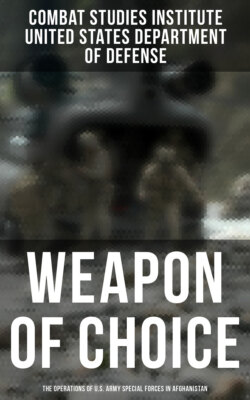Читать книгу Weapon of Choice: The Operations of U.S. Army Special Forces in Afghanistan - Combat Studies Institute - Страница 4
На сайте Литреса книга снята с продажи.
Introduction
ОглавлениеTable of Contents
The purpose of this book is to share Army special operations soldier stories with the general American public to show them what various elements accomplished during the war to drive the Taliban from power and to destroy al-Qaeda and Taliban strongholds in Afghanistan as part of the global war on terrorism. The purpose of the book is not to resolve Army special operations doctrinal issues, to clarify or update military definitions, or to be the “definitive” history of the continuing unconventional war in Afghanistan. The purpose is to demonstrate how the war to drive the Taliban from power, help the Afghan people, and assist the Afghan Interim Authority (AIA) rebuild the country afterward was successfully accomplished by majors, captains, warrant officers, and sergeants on tactical teams and aircrews at the lowest levels. If Army special operations forces (ARSOF) operations and the operational employment of teams in Afghanistan by various Joint Special Operaions Task Forces (JSOTFs) create doctrinal debate, the appropriate venue within which to resolve those issues is at the U.S. Army Special Warfare Center and School. Combat operations in Afghanistan remain classified by the U.S. Central Command (CENTCOM). This is a carefully “sanitized” rendering of selected combat operations, and used pseudonyms for military personnel in the grade of lieutenant colonel and below (unless the individuals had received so much media exposure that this simple security measure would be meaningless). Likewise, the “eyes” of ARSOF personnel below the grade of colonel have been “blacked-out” in the photos for operational security (OPSEC) reasons. Chapter introductions and the vignettes have been written so that individuals with little previous knowledge of the military can understand and appreciate the contributions of the small Army special operations units that succeeded in driving the Taliban from power in Afghanistan.
The selected historical vignettes tell the ARSOF story. Many of these soldier stories demonstrate the capabilities of special operations forces (SOF)-unique equipment, while others point out the skills and bravery of the soldiers and aviators. The strength of ARSOF resides in its highly trained, very motivated soldiers. While technology plays a part in ARSOF, the soldiers make the difference. There has been a conscious effort to ensure that the stories of all ARSOF elements are presented. Thus, to provide a fair representative sampling of different activities within the security constraints, not all interviews became vignettes. One hundred-percent coverage of all participating teams was impossible. The examples selected were the best of those available to demonstrate a capability, illustrate an activity, or clarify a combat mission. The sensitive classified parts have been sanitized based on specific security rules, hence special forces elements do not always mean special forces teams, and pseudonyms are used predominantly. A limited-access U.S. Army Special Operations Command (USSOCOM) classified annex of sources will contain true names and specify documents and briefings to corroborate the material included. The controlled classified annex will not be available to researchers who do not have the appropriate security clearances and a clear “need to know.”
This historical project is not intended to be the definitive study of the war in Afghanistan. It is a “snapshot” of the war from 11 September 2001 until the middle of May 2002. Since the published word promotes analysis and provokes discussion, the first official account of this successful unconventional war should come from Army Special Operations because they spearheaded the ground campaign that forced the Taliban from power in Afghanistan. The vignettes are based primarily on recorded interviews, after-action reports, personal notes of participants, and tactical operations center (TOC) logs. Open secondary sources were also used, but for this operations history, the recorded interviews of soldiers from tactical teams to various JSOTF and Special Operations Command Central (SOCCENT) staff personnel proved to be the most valuable. Where minor differences were found between accounts by a tactical team and headquarters records and cross-referencing corroborated data provided by the “team on the ground,” that was adopted. In the interest of producing a timely product while the war was still “fresh,” discrepancies that could not be resolved satisfactorily were handled by the project director who evaluated importance, relevance, and whether they contributed to or confused the issue.
This is a current history of war. The decision to have professional historians with ARSOF experience capture the history of current operations in Afghanistan is proof that the book is not intended to be a public relations piece. War and combat have never been “all sunshine and roses.” Just as campaign plans and units orders tend to “go to the winds” once the fighting starts, reluctant and ill-prepared leaders are replaced, confusion and incomplete information are relegated to the “fog of war,” and recollections from the headquarters afterward as to what really happened on the ground tend to dominate after-the-battle reports. The writing team— composed of retired ARSOF veterans—understood those “given” elements. When everything goes according to plan, professional soldiers consider it an anomaly. Thus, to reach 95-percent objectivity, the writing team veterans kept the following sports adage in mind: “It’s easy to fool the fans, but you can’t fool the players.” While observations and reflections are included, complete analysis can be done only when the ARSOF mission in Afghanistan is concluded.
